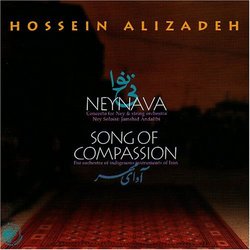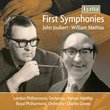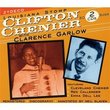| All Artists: Hossein Alizadeh Title: NeyNava / Song of Compassion Members Wishing: 1 Total Copies: 0 Label: Kereshmeh Records Release Date: 6/1/1995 Genres: Dance & Electronic, International Music, Pop Styles: World Dance, Europe, Continental Europe, Middle East, Iran Number of Discs: 1 SwapaCD Credits: 1 UPC: 786417010329 |
Search - Hossein Alizadeh :: NeyNava / Song of Compassion
 | Hossein Alizadeh NeyNava / Song of Compassion Genres: Dance & Electronic, International Music, Pop
NeyNava is probably the most famous piece of Persian music composed in the past twenty years of Iran's musical history. It is an eternal piece. In your first listening you will feel it under your skin. It will talk to you ... more » |
Larger Image |
CD DetailsSynopsis
Album Description NeyNava is probably the most famous piece of Persian music composed in the past twenty years of Iran's musical history. It is an eternal piece. In your first listening you will feel it under your skin. It will talk to you and remind of a musical paradise. It is a true fusion of the western precision and the eastern mysticism. NeyNava translates as 'the sound of Ney', and is written in Dastgah Nava, which is known for its mystically contemplative atmosphere. It takes up the concerto form with a fully western string orchestra as its accompaniment. NeyNava wonderfully introduces the tone of Ney, which can sound both warm and crisp to the western listener. This recording has been digitally restored from the original performance in 1984 by the String Orchestra of the National Iranian Radio and Television. Song of Compassion was written as a requiem for the victims of the devastating earthquake in the northern region of Iran in 1990. It is one of the few expressionistic compositions written for indigenous Persian instruments. The wonderful color and thematic depth of this work makes it emotionally engaging and effective in its expression of the tragedy and compassion for the event. Song of Compassion is an outcry of bold musical content; its melodies will make you feel the agony of the earthquake and its rhythms will remind you of the everlasting powerful force of life. Similar CDsSimilarly Requested CDs
|
CD ReviewsThe witness in the corner Nader F. | Brookline, MA | 09/04/2004 (5 out of 5 stars) "It can't be but because of passion and love for his rich musical inheritance that Hossein Alizadeh can bring hereto hidden voices from traditional Persian music to shine as the center pieces of a complex composition in which he invites the Western system as a universal "goushe". Goushes can be loosely called "variations" within a single compositional system [dastgah] in Persian traditional music. But it is much more complex than that. Goushes have more to do with recalling possibilities demanded by the temporal understanding of the music at hand than a set way of interpretation. So, to call the "Western" guest a goushe may sound sacrilegious to some purists. But given that goushe has many interpretations, let me the liberty to interpret it as more linguistically as "witness", rather than "corner", as it is usually done. Later you will see that this "witness" will get involved with equal stature. Goushe was the person who would sit in one of the several rooms surrounding a traditional residential entry hall in Iran. The person would listen to the business or legal conversations of his master and his guests and be a "witness" or a reminder. The goushe would not participate in person as a sign of respect for the guests. But a goushe was legally equivalence of a physically present witness. The gouche's ear was all that mattered, and like a written account, it wouldn't carry any interpretations of the physical interaction of the parties. To use a gouche was an accepted practice when a witness with the same stature of the guest could not be brought in. Thus we can imagine that here Hossein Alizadeh brings in Western "forms" to witness the nearly infinite array of possibilities in seemingly rigid Persian compositional system. This witnessing affects how the witnessed act and play. Each western tempo, be it dance, military, or processional, brings out melodies and rhythms from Persian dastgahs in a one to one and then one to many relationships. A single western form evokes multitude Persian "shapes". But, beyond the playful game of precedence, there is also the interplay between the dastgahs in this new environment created by introducing a foreign witness. Alizadeh goes a long way toward showing that by "witnessing" the Persian through the formalized, often linear western system, we can dust off lost insights and express musical ideas that truly have no edge, no border, nor fronts. The linear becomes tesseletated into fractured wholes. The number of layers of patterns in these compositions is no less than interwoven patterns "flattened" onto a single surface in the tile designs of the sixteenth century masters. By weaving natural and geometric layers into stories forbidden by the religious sytem or "dastgah" the tile designers mixed human concepts and natural shapes to express the harmony between the two. Thus, a third wonderful game in these compositions appears as the place of natural "voice". In these pieces Persian melodies are usually voiced by the ney while Western melodies by strings. Then the presence of a natural voice, although abstracted, changes this. In these instance Western melodies voice through the Ney. Similarly for percussion instruments. The daf and the tomabak take turns carrying the two systems, adding new layers of geometric "pattern". These studies by Mr. Alizadeh accumulate added significance as time goes on. One discovers, and resolves, new complexities with each listening, with the pieces becoming more mystifying in their clarity. One can hear the joy, sadness, and mythical ecstasies of different poems in major dastgahs which here commingle in the presence of a new "witness" [goushe]. Hossein Alizadeh is convincing us that this "witness" SHOULD be made a permanent friend. " Greatest living instrumentalist of Persian traditional music pashmak | Cleveland, OH United States | 01/04/2001 (5 out of 5 stars) "Hossein Alizadeh is the greatest living instrumentalist of Persian traditional music and this work is one of his greatest compositions. If you desire purity of the ancient tradition combined with innovations of a great musician, Alizadeh is the person to listen to. If the music is new for you and sounds a bit strange in the beginning, listen to it with closed eyes for a while and more than once. Persian traditional music, like all introverted and esotric traditions, is a bit more difficult to grasp at first, but its emotional and intellectual rewards by far out-weighs the little extra effort one has to spend in the beginning." This music carries you away... mecki2 | Wien/Vienna Austria | 12/11/2002 (5 out of 5 stars) "I heard this music for the first time in a Persian restaurant in Porto/Portugal. It instantly carried me away so I had to get the
CD. The owner of the restaurant only had an old cassette. I made a photo of this cassette, got the persian text translated by a persian colleague, searched a bit on the net and now I found it at Amazon. Great!" |

 Track Listings (11) - Disc #1
Track Listings (11) - Disc #1




